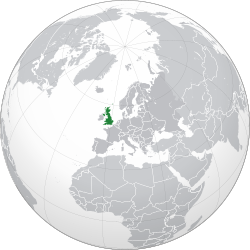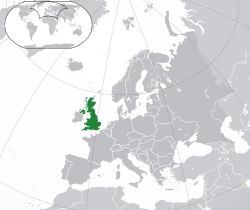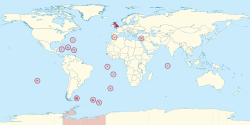
A | B | C | D | E | F | G | H | CH | I | J | K | L | M | N | O | P | Q | R | S | T | U | V | W | X | Y | Z | 0 | 1 | 2 | 3 | 4 | 5 | 6 | 7 | 8 | 9
United Kingdom of Great Britain and Northern Ireland | |
|---|---|
| Anthem: "God Save the King"[a] | |
Coats of arms: Used in relation to Scotland (right) and elsewhere (left) | |
| Capital and largest city | London 51°30′N 0°7′W / 51.500°N 0.117°W |
| National language | |
| Regional and minority languages[b] | |
| Ethnic groups | |
| Religion | List
|
| Demonym(s) |
|
| Government | Unitary[d] parliamentary constitutional monarchy |
• Monarch | Charles III |
| Rishi Sunak | |
| Legislature | Parliament |
| House of Lords | |
| House of Commons | |
| Formation | |
| 1535 and 1542 | |
| 24 March 1603 | |
| 22 July 1706 | |
| 1 May 1707 | |
| 1 January 1801 | |
| 6 December 1922 | |
| Area | |
• Total[e] | 244,376 km2 (94,354 sq mi)[12] (78th) |
• Land[f] | 242,741 km2 (93,723 sq mi)[12] |
| Population | |
• 2022 estimate | |
• 2021/22 census | 66,940,559[c][14][15][16] |
• Density | 279/km2 (722.6/sq mi)[13] (51st) |
| GDP (PPP) | 2024 estimate |
• Total | |
• Per capita | |
| GDP (nominal) | 2024 estimate |
• Total | |
• Per capita | |
| Gini (2021) | medium |
| HDI (2022) | very high (15th) |
| Currency | Pound sterling[g] (GBP) |
| Time zone | UTC+0 (GMT) |
• Summer (DST) | UTC+1 (BST[h]) |
| Date format | dd/mm/yyyy (AD)[i] |
| Driving side | left[j] |
| Calling code | +44[k] |
| ISO 3166 code | GB |
| Internet TLD | .uk[l] |
The United Kingdom of Great Britain and Northern Ireland, commonly known as the United Kingdom (UK) or Britain,[m] is a country in Northwestern Europe, off the coast of the continental mainland.[21][22] It comprises England, Scotland, Wales, and Northern Ireland.[n][23] The UK includes the island of Great Britain, the north-eastern part of the island of Ireland, and most of the smaller islands within the British Isles.[24] Northern Ireland shares a land border with the Republic of Ireland; otherwise, the United Kingdom is surrounded by the Atlantic Ocean, the North Sea, the English Channel, the Celtic Sea, and the Irish Sea. The total area of the United Kingdom is 94,354 square miles (244,376 km2),[e][12] with an estimated population of nearly 67.6 million people in 2022.[13]
In 1707, the Kingdom of England (which included Wales) and the Kingdom of Scotland united under the Treaty of Union to create the Kingdom of Great Britain. The Acts of Union 1800 incorporated the Kingdom of Ireland to create the United Kingdom of Great Britain and Ireland in 1801. Most of Ireland seceded from the UK in 1922 as the Irish Free State, and the Royal and Parliamentary Titles Act 1927 created the present name, the United Kingdom of Great Britain and Northern Ireland.
The UK became the first industrialised country and was the world's foremost power for the majority of the 19th and early 20th centuries, particularly during the "Pax Britannica" between 1815 and 1914.[25][26] At its height in the 1920s, the British Empire encompassed almost a quarter of the world's landmass and population, and was the largest empire in history. However, its involvement in the First World War and the Second World War damaged Britain's economic power and a global wave of decolonisation led to the independence of most British colonies.[27][28][29] British influence can be observed in the legal and political systems of many of its former colonies, and British culture remains globally influential, particularly in language, literature, music and sport. English is the world's most widely spoken language and the third-most spoken native language.[30]
The United Kingdom is a constitutional monarchy and parliamentary democracy.[o][32] The UK has three distinct jurisdictions; England and Wales, Scotland and Northern Ireland.[33] Since 1998, Scotland, Wales and Northern Ireland have their own devolved governments and legislatures while England is governed directly by the UK Government.[34] The capital and largest city of the United Kingdom (as well as the capital of England) is London, a global metropolis with a metropolitan population of over 14 million. The cities of Edinburgh, Cardiff, and Belfast are the national capitals of Scotland, Wales, and Northern Ireland respectively. Other major cities include Birmingham, Manchester, Glasgow, Liverpool and Leeds.
The UK is a developed country and has the world's sixth-largest economy by nominal gross domestic product (GDP). It is a recognised nuclear state, and is ranked fourth globally in military expenditure.[35][36] The UK has been a permanent member of the UN Security Council since its first session in 1946. It is a member of the Commonwealth of Nations, the Council of Europe, the G7, the OECD, NATO, the Five Eyes, AUKUS and the CPTPP.
Etymology and terminology
The Acts of Union 1707 declared that the Kingdom of England and Kingdom of Scotland were "United into One Kingdom by the Name of Great Britain".[p][37] The term "United Kingdom" has occasionally been used as a description for the former Kingdom of Great Britain, although its official name from 1707 to 1800 was simply "Great Britain".[38] The Acts of Union 1800 united the kingdoms of Great Britain and Ireland in 1801, forming the United Kingdom of Great Britain and Ireland. Following the partition of Ireland and the independence of the Irish Free State in 1922, which left Northern Ireland as the only part of the island of Ireland within the United Kingdom, the name was changed in 1927 to the "United Kingdom of Great Britain and Northern Ireland".[39]
Although the United Kingdom is a sovereign country, England, Scotland, Wales and Northern Ireland are also widely referred to as countries.[40] The UK Prime Minister's website has used the phrase "countries within a country" to describe the United Kingdom.[41] Some statistical summaries, such as those for the twelve NUTS 1 regions refer to Scotland, Wales and Northern Ireland as "regions".[42] Northern Ireland is also referred to as a "province".[43] With regard to Northern Ireland, the descriptive name used "can be controversial, with the choice often revealing one's political preferences".[44]
The term "Great Britain" conventionally refers to the island of Great Britain, or politically to England, Scotland and Wales in combination.[45] It is sometimes used as a loose synonym for the United Kingdom as a whole.[46] The word England is occasionally used incorrectly to refer to the United Kingdom as a whole, a mistake principally made by people from outside the UK.[47]
The term "Britain" is used as a synonym for Great Britain,[48][49] and the United Kingdom.[50][49] Usage is mixed: the UK Government prefers to use the term "UK" rather than "Britain" or "British" on its website (except when referring to embassies),[51] while acknowledging that both terms refer to the United Kingdom and that elsewhere "British government" is used at least as frequently as "United Kingdom government".[52] The UK Permanent Committee on Geographical Names recognises "United Kingdom", "UK" and "U.K." as shortened and abbreviated geopolitical terms for the United Kingdom of Great Britain and Northern Ireland in its toponymic guidelines; it does not list "Britain" but notes that "it is only the one specific nominal term 'Great Britain' which invariably excludes Northern Ireland".[52] The BBC historically preferred to use "Britain" as shorthand only for Great Britain, though the present style guide does not take a position except that "Great Britain" excludes Northern Ireland.[53]
The adjective "British" is commonly used to refer to matters relating to the United Kingdom and is used in law to refer to United Kingdom citizenship and matters to do with nationality.[54] People of the United Kingdom use several different terms to describe their national identity and may identify themselves as being British, English, Scottish, Welsh, Northern Irish, or Irish;[55] or as having a combination of different national identities.[56] The official designation for a citizen of the United Kingdom is "British citizen".[52]
History
Prior to the Treaty of Union
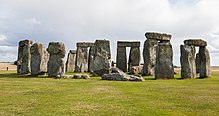
Settlement by Cro-Magnons of what was to become the United Kingdom occurred in waves beginning by about 30,000 years ago.[57] The island has been continuously inhabited only since the last retreat of the ice around 11,500 years ago. By the end of the region's prehistoric period, the population is thought to have belonged largely to a culture termed Insular Celtic, comprising Brittonic Britain and Gaelic Ireland.[58]

The Roman conquest, beginning in 43 AD, and the 400-year rule of southern Britain, was followed by an invasion by Germanic Anglo-Saxon settlers, reducing the Brittonic area mainly to what was to become Wales, Cornwall and, until the latter stages of the Anglo-Saxon settlement, the Hen Ogledd (northern England and parts of southern Scotland).[59] Most of the region settled by the Anglo-Saxons became unified as the Kingdom of England in the 10th century.[60] Meanwhile, Gaelic-speakers in north-west Britain (with connections to the north-east of Ireland and traditionally supposed to have migrated from there in the 5th century)[61] united with the Picts to create the Kingdom of Scotland in the 9th century.[62]

In 1066, the Normans invaded England from northern France. After conquering England, they seized large parts of Wales, conquered much of Ireland and were invited to settle in Scotland, bringing to each country feudalism on the Northern French model and Norman-French culture.[63] The Anglo-Norman ruling class greatly influenced, but eventually assimilated with, the local cultures.[64] Subsequent medieval English kings completed the conquest of Wales and tried unsuccessfully to annex Scotland. Asserting its independence in the 1320 Declaration of Arbroath, Scotland maintained its independence thereafter, albeit in near-constant conflict with England.
In 1215 the Magna Carta was the first document to state that no government was above the law, that citizens have rights protecting them and that they were entitled to a fair trial.[65]
The English monarchs, through inheritance of substantial territories in France and claims to the French crown, were also heavily involved in conflicts in France, most notably the Hundred Years' War, while the Kings of Scots were in an alliance with the French during this period.[66] Early modern Britain saw religious conflict resulting from the Reformation and the introduction of Protestant state churches in each country.[67] The English Reformation ushered in political, constitutional, social and cultural change in the 16th century and established the Church of England. Moreover, it defined a national identity for England and slowly, but profoundly, changed people's religious beliefs.[68] Wales was fully incorporated into the Kingdom of England,[69] and Ireland was constituted as a kingdom in personal union with the English crown.[70] In what was to become Northern Ireland, the lands of the independent Catholic Gaelic nobility were confiscated and given to Protestant settlers from England and Scotland.[71]
In 1603, the kingdoms of England, Scotland and Ireland were united in a personal union when James VI, King of Scots, inherited the crowns of England and Ireland and moved his court from Edinburgh to London; each country nevertheless remained a separate political entity and retained its separate political, legal, and religious institutions.[72]
In the mid-17th century, all three kingdoms were involved in a series of connected wars (including the English Civil War) which led to the temporary overthrow of the monarchy, with the execution of King Charles I, and the establishment of the short-lived unitary republic of the Commonwealth of England, Scotland and Ireland.[73]
Although the monarchy was restored, the Interregnum along with the Glorious Revolution of 1688 and the subsequent Bill of Rights 1689 in England and Claim of Right Act 1689 in Scotland ensured that, unlike much of the rest of Europe, royal absolutism would not prevail, and a professed Catholic could never accede to the throne. The British constitution would develop on the basis of constitutional monarchy and the parliamentary system.[74] With the founding of the Royal Society in 1660, science was greatly encouraged. During this period, particularly in England, the development of naval power and the interest in voyages of discovery led to the acquisition and settlement of overseas colonies, particularly in North America and the Caribbean.[75]
Though previous attempts at uniting the two kingdoms within Great Britain in 1606, 1667, and 1689 had proved unsuccessful, the attempt initiated in 1705 led to the Treaty of Union of 1706 being agreed and ratified by both parliaments.
Kingdom of Great Britain
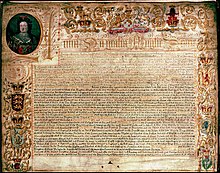
On 1 May 1707, the Kingdom of Great Britain was formed, the result of the Acts of Union 1707.[76] In the 18th century, cabinet government developed under Robert Walpole, in practice the first prime minister (1721–1742). A series of Jacobite uprisings sought to remove the Protestant House of Hanover from the throne and restore the Catholic House of Stuart. The Jacobites were finally defeated at the Battle of Culloden in 1746, after which the Scottish Highlanders were forcibly assimilated into Scotland by revoking the feudal independence of clan chiefs. The British colonies in North America that broke away in the American War of Independence became the United States, recognised by Britain in 1783. British imperial ambition turned towards Asia, particularly to India.[77]
British merchants played a leading part in the Atlantic slave trade, mainly between 1662 and 1807 when British or British-colonial slave ships transported nearly 3.3 million slaves from Africa.[78] The slaves were taken to work on plantations, principally in the Caribbean but also North America.[79] However, with pressure from the abolitionism movement, Parliament banned the trade in 1807, banned slavery in the British Empire in 1833, and Britain took a leading role in the movement to abolish slavery worldwide through the blockade of Africa and pressing other nations to end their trade with a series of treaties.[80]
United Kingdom of Great Britain and Ireland
In 1800 the parliaments of Great Britain and Ireland each passed an Act of Union, uniting the two kingdoms and creating the United Kingdom of Great Britain and Ireland on 1 January 1801.[81]

After the defeat of France at the end of the French Revolutionary Wars and Napoleonic Wars (1792–1815), the United Kingdom emerged as the principal naval and imperial power (with London the largest city in the world from about 1830).[82] Unchallenged at sea, British dominance was later described as Pax Britannica ("British Peace"), a period of relative peace among the great powers (1815–1914) during which the British Empire became the global hegemon and adopted the role of global policeman.[83] By the time of the Great Exhibition of 1851, Britain was described as the "workshop of the world".[84] From 1853 to 1856, Britain took part in the Crimean War, allied with the Ottoman Empire against Tsarist Russia,[85] participating in the naval battles of the Baltic Sea known as the Åland War in the Gulf of Bothnia and the Gulf of Finland, among others.[86] Following the Indian Rebellion in 1857, the British government led by Lord Palmerston assumed direct rule over India. Alongside the formal control it exerted over its own colonies, British dominance of much of world trade meant that it effectively controlled the economies of regions such as East Asia and Latin America.[87]
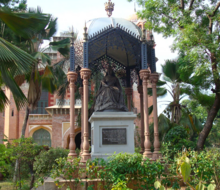
Throughout the Victorian era, political attitudes favoured free trade and laissez-faire policies. Beginning with the Great Reform Act in 1832, Parliament gradually widened the voting franchise, with the 1884 Reform Act championed by William Gladstone granting suffrage to a majority of males for the first time. The British population increased at a dramatic rate, accompanied by rapid urbanisation, causing significant social and economic stresses.[88] By the late 19th century, the Conservatives under Benjamin Disraeli and Lord Salisbury initiated a period of imperial expansion in Africa, maintained a policy of splendid isolation in Europe, and attempted to contain Russian influence in Afghanistan and Persia, in what came to be known as the Great Game.[89] During this time, Canada, Australia and New Zealand were granted self-governing dominion status.[90] At the turn of the century, Britain's industrial dominance became challenged by the German Empire and the United States.[91] The Edwardian era saw social reform and home rule for Ireland become important domestic issues, while the Labour Party emerged from an alliance of trade unions and small socialist groups in 1900, and suffragettes campaigned for women's right to vote.[92]
World wars and partition of Ireland

Britain was one of the principal Allies that defeated the Central Powers in the First World War (1914–1918). Alongside their French, Russian and (after 1917) American counterparts,[93] British armed forces were engaged across much of the British Empire and in several regions of Europe, particularly on the Western Front.[94] The high fatalities of trench warfare caused the loss of much of a generation of men, with lasting social effects in the nation and a great disruption in the social order. Britain had suffered 2.5 million casualties and finished the war with a huge national debt.[94] The consequences of the war persuaded the government to expand the right to vote in national and local elections to all adult men and most adult women with the Representation of the People Act 1918.[94] After the war, Britain became a permanent member of the Executive Council of the League of Nations and received a mandate over a number of former German and Ottoman colonies. Under the leadership of David Lloyd George, the British Empire reached its greatest extent, covering a fifth of the world's land surface and a quarter of its population.[95]
By the mid-1920s, most of the British population could listen to BBC radio programmes.[96][97] Experimental television broadcasts began in 1929 and the first scheduled BBC Television Service commenced in 1936.[98] The rise of Irish nationalism, and disputes within Ireland over the terms of Irish Home Rule, led eventually to the partition of the island in 1921.[99] The Irish Free State became independent, initially with Dominion status in 1922, and unambiguously independent in 1931. Northern Ireland remained part of the United Kingdom.[100] The 1928 Equal Franchise Act gave women electoral equality with men in national elections. Strikes in the mid-1920s culminated in the General Strike of 1926, which ended in a victory for the government led by Stanley Baldwin. Britain had still not recovered from the effects of the First World War when the Great Depression (1929–1932) led to considerable unemployment and hardship in the old industrial areas, as well as political and social unrest with rising membership in communist and socialist parties. A coalition government was formed in 1931.[101]
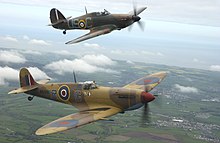
Nonetheless, "Britain was a very wealthy country, formidable in arms, ruthless in pursuit of its interests and sitting at the heart of a global production system."[102] After Nazi Germany invaded Poland in 1939, Britain entered the Second World War. Winston Churchill became prime minister and head of a coalition government in 1940. Despite the defeat of its European allies in the first year, Britain and its Empire continued the war against Germany. Churchill engaged industry, scientists and engineers to support the government and the military in the prosecution of the war effort.[102]
In 1940, the Royal Air Force defeated the German Luftwaffe in the Battle of Britain. Urban areas suffered heavy bombing during the Blitz. The Grand Alliance of Britain, the United States and the Soviet Union formed in 1941, leading the Allies against the Axis powers. There were eventual hard-fought victories in the Battle of the Atlantic, the North Africa campaign and the Italian campaign. British forces played important roles in the Normandy landings of 1944 and the liberation of Europe. The British Army led the Burma campaign against Japan, and the British Pacific Fleet fought Japan at sea. British scientists contributed to the Manhattan Project whose task was to build an atomic weapon.[103] Once built, it was decided, with British consent, to use the weapon against Japan.[104] The wartime net losses in British national wealth amounted to 18.6% (£4.595 billion) of the prewar wealth (£24.68 billion), at 1938 prices.[105]
Postwar 20th century

The UK was one of the Big Three powers (along with the US and the Soviet Union) who met to plan the post-war world;[106] it drafted the Declaration by United Nations with the United States and became one of the five permanent members of the United Nations Security Council. It worked closely with the United States to establish the IMF, World Bank and NATO.[107] The war left the UK severely weakened and financially dependent on the Marshall Plan,[108] but it was spared the total war that devastated eastern Europe.[109]
In the immediate post-war years, the Labour government under Clement Attlee initiated a radical programme of reforms, which significantly impacted British society in the following decades.[110] Major industries and public utilities were nationalised, a welfare state was established, and a comprehensive, publicly funded healthcare system, the National Health Service, was created.[111] The rise of nationalism in the colonies coincided with Britain's much-diminished economic position, so that a policy of decolonisation was unavoidable. Independence was granted to India and Pakistan in 1947.[112] Over the next three decades, most colonies of the British Empire gained their independence, and many became members of the Commonwealth of Nations.[113]
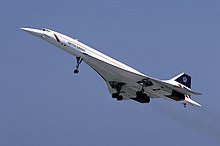
The UK was the third country to develop a nuclear weapons arsenal (with its first atomic bomb test, Operation Hurricane, in 1952), but the post-war limits of Britain's international role were illustrated by the Suez Crisis of 1956. The international spread of the English language ensured the continuing international influence of its literature and culture.[115][116] As a result of a shortage of workers in the 1950s, the government encouraged immigration from Commonwealth countries. In the following decades, the UK became a more multi-ethnic society.[117] Despite rising living standards in the late 1950s and 1960s, the UK's economic performance was less successful than many of its main competitors such as France, West Germany and Japan. The UK was the first democratic nation to lower its voting age to 18 in 1969.[118]
In the decades-long process of European integration, the UK was a founding member of the Western European Union, established with the London and Paris Conferences in 1954. In 1960 the UK was one of the seven founding members of the European Free Trade Association (EFTA), but in 1973 it left to join the European Communities (EC). In a 1975 referendum 67% voted to stay in it.[119] When the EC became the European Union (EU) in 1992, the UK was one of the 12 founding member states.
From the late 1960s, Northern Ireland suffered communal and paramilitary violence (sometimes affecting other parts of the UK) conventionally known as the Troubles. It is usually considered to have ended with the 1998 Belfast "Good Friday" Agreement.[120]

Following a period of widespread economic slowdown and industrial strife in the 1970s, the Conservative government of the 1980s led by Margaret Thatcher initiated a radical policy of monetarism, deregulation, particularly of the financial sector (for example, the Big Bang in 1986) and labour markets, the sale of state-owned companies (privatisation), and the withdrawal of subsidies to others.[121]
In 1982, Argentina invaded the British territories of South Georgia and the Falkland Islands, leading to the 10-week Falklands War in which Argentine forces were defeated. The inhabitants of the islands are predominantly descendants of British settlers, and strongly favour British sovereignty, expressed in a 2013 referendum. From 1984, the UK economy was helped by the inflow of substantial North Sea oil revenues.[122]
Another British overseas territory, Gibraltar, ceded to Great Britain in the 1713 Treaty of Utrecht,[123] is a key military base for the UK. A referendum in 2002 on shared sovereignty with Spain was rejected by 98.97% of voters in the territory.
Around the end of the 20th century, there were major changes to the governance of the UK with the establishment of devolved administrations for Scotland, Wales and Northern Ireland.[124] The statutory incorporation followed acceptance of the European Convention on Human Rights. The UK remained a great power with global diplomatic and military influence and a leading role in the United Nations and NATO.[125]
21st century

The UK broadly supported the United States' approach to the "war on terror" in the early 21st century.[126] British troops fought in the War in Afghanistan, but controversy surrounded Britain's military deployment in Iraq, which saw the largest protest in British history demonstrating in opposition to the government led by Tony Blair.[127]
The 2008 global financial crisis severely affected the UK economy.[128] The Cameron–Clegg coalition government of 2010 introduced austerity measures intended to tackle the substantial public deficits.[129] Studies have suggested that policy led to significant social disruption and suffering.[130][131] A referendum on Scottish independence in 2014 resulted in the Scottish electorate voting by 55.3 to 44.7% to remain part of the United Kingdom.[132]
In 2016, 51.9 per cent of voters in the United Kingdom voted to leave the European Union.[133] The UK left the EU in 2020.[134] On 1 May 2021 the EU–UK Trade and Cooperation Agreement came into force.[135]
The COVID-19 pandemic had a severe impact on the UK's economy, caused major disruptions to education and had far-reaching impacts on society and politics in 2020 and 2021.[136][137][138] The United Kingdom was the first country in the world to use an approved COVID-19 vaccine, developing its own vaccine through a collaboration between Oxford University and AstraZeneca, which allowed the UK's vaccine rollout to be among the fastest in the world.[139][140]
On 8 September 2022, Elizabeth II, the longest-living and longest-reigning British monarch, died at the age of 96.[141] Upon the Queen's death, her eldest child Charles, Prince of Wales, acceded to the British throne as Charles III.[142]
Geography

The total area of the United Kingdom is approximately 94,354 square miles (244,376 km2),[e][12] with a land area of 93,723 square miles (242,741 km2).[12] The country occupies the major part of the British Isles[143] archipelago and includes the island of Great Britain, the north-eastern one-sixth of the island of Ireland and some smaller surrounding islands. It lies between the North Atlantic Ocean and the North Sea with the southeast coast coming within 22 miles (35 km) of the coast of northern France, from which it is separated by the English Channel.[144]
The Royal Greenwich Observatory in London was chosen as the defining point of the Prime Meridian[145] at the International Meridian Conference in 1884.[146]
The United Kingdom lies between latitudes 49° and 61° N, and longitudes 9° W and 2° E. Northern Ireland shares a 224-mile (360 km) land boundary with the Republic of Ireland.[144] The coastline of Great Britain is 11,073 miles (17,820 km) long.[147] It is connected to continental Europe by the Channel Tunnel, which at 31 miles (50 km) (24 miles (38 km) underwater) is the longest underwater tunnel in the world.[148]
The UK contains four terrestrial ecoregions: Celtic broadleaf forests, English Lowlands beech forests, North Atlantic moist mixed forests, and Caledon conifer forests.[149] The area of woodland in the UK in 2023 is estimated to be 3.25 million hectares, which represents 13% of the total land area in the UK.[150]
Climate
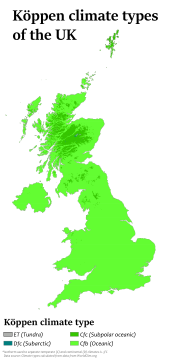
Most of the United Kingdom has a temperate climate, with generally cool temperatures and plentiful rainfall all year round.[144] The temperature varies with the seasons seldom dropping below 0 °C (32 °F) or rising above 30 °C (86 °F).[151] Some parts, away from the coast, of upland England, Wales, Northern Ireland and most of Scotland, experience a subpolar oceanic climate (Cfc). Higher elevations in Scotland experience a continental subarctic climate (Dfc) and the mountains experience a tundra climate (ET).[152]
The prevailing wind is from the southwest and bears frequent spells of mild and wet weather from the Atlantic Ocean,[144] although the eastern parts are mostly sheltered from this wind. Since the majority of the rain falls over the western regions, the eastern parts are the driest. Atlantic currents, warmed by the Gulf Stream, bring mild winters, especially in the west where winters are wet and even more so over high ground. Summers are warmest in the southeast of England and coolest in the north. Heavy snowfall can occur in winter and early spring on high ground, and occasionally settles to great depth away from the hills.[153]
The average total annual sunshine in the United Kingdom is 1339.7 hours, which is just under 30% of the maximum possible.[154] The hours of sunshine vary from 1200 to about 1580 hours per year, and since 1996 the UK has been and still is receiving above the 1981 to 2010 average hours of sunshine.[155]
As of 2022, the United Kingdom is ranked 2nd out of 180 countries in the Environmental Performance Index.[156] A law has been passed that UK greenhouse gas emissions will be net zero by 2050.[157]
Topography
England accounts for 53 per cent of the UK, covering 50,350 square miles (130,395 km2).[158] Most of the country consists of lowland terrain,[159] with upland and mountainous terrain northwest of the Tees–Exe line which roughly divides the UK into lowland and upland areas. Lowland areas include Cornwall, the New Forest, the South Downs and the Norfolk Broads. Upland areas include the Lake District, the Pennines, the Yorkshire Dales, Exmoor, and Dartmoor. The main rivers and estuaries are the Thames, Severn, and the Humber. England's highest mountain is Scafell Pike, at 978 metres (3,209 ft) in the Lake District; its largest island is the Isle of Wight.

Scotland accounts for 32 per cent of the UK, covering 30,410 square miles (78,772 km2).[160] This includes nearly 800 islands,[161] notably the Hebrides, Orkney Islands and Shetland Islands. Scotland is the most mountainous constituent country of the UK, the Highlands to the north and west are the more rugged region containing the majority of Scotland's mountainous land, including the Cairngorms, Loch Lomond and The Trossachs and Ben Nevis which at 1,345 metres (4,413 ft)[162] is the highest point in the British Isles.[163]
Wales accounts for less than 9 per cent of the UK, covering 8,020 square miles (20,779 km2).[164] Wales is mostly mountainous, though South Wales is less mountainous than North and mid Wales. The highest mountains in Wales are in Snowdonia and include Snowdon (Welsh: Yr Wyddfa) which, at 1,085 metres (3,560 ft), is the highest peak in Wales.[159] Wales has over 1,680 miles (2,704 kilometres) of coastline including the Pembrokeshire Coast.[147] Several islands lie off the Welsh mainland, the largest of which is Anglesey (Ynys Môn).
Northern Ireland, separated from Great Britain by the Irish Sea and North Channel, has an area of 5,470 square miles (14,160 km2) and is mostly hilly. It includes Lough Neagh which, at 150 square miles (388 km2), is the largest lake in the British Isles by area,[165] Lough Erne which has over 150 islands and the Giant's Causeway which is a World Heritage Site. The highest peak in Northern Ireland is Slieve Donard in the Mourne Mountains at 852 metres (2,795 ft).[159]
Politics

The UK is a constitutional monarchy and a parliamentary democracy operating under the Westminster system, otherwise known as a "democratic parliamentary monarchy".[166] It is a centralised, unitary state[167][168] wherein the Parliament of the United Kingdom is sovereign.[169] Parliament is made up of the elected House of Commons, the appointed House of Lords and the Crown (as personified by the monarch).[q][172] The main business of parliament takes place in the two houses,[172] but royal assent is required for a bill to become an act of parliament (that is, statute law).[173] As a result of parliamentary sovereignty, the British constitution is uncodified, consisting mostly of disparate written sources, including parliamentary statutes, judge-made case law and international treaties, together with constitutional conventions.[174] Nevertheless, the Supreme Court recognises a number of principles underlying the British constitution, such as parliamentary sovereignty, the rule of law, democracy, and upholding international law.[175]
King Charles III is the current monarch and head of state of the UK and of 14 other independent countries. These 15 countries are today referred to as "Commonwealth realms". The monarch is formally vested with all executive authority as the personal embodiment of the Crown and is "...fundamental to the law and working of government in the UK."[176] The disposition of such powers however, including those belonging to the royal prerogative, is generally exercised only on the advice of ministers of the Crown responsible to Parliament and thence to the electorate. Nevertheless, in the performance of official duties, the monarch has "the right to be consulted, the right to encourage, and the right to warn".[177] In addition, the monarch has a number of reserve powers at his disposal, albeit rarely used, to uphold responsible government and prevent constitutional crises.[r]
For general elections (elections to the House of Commons), the UK is currently divided into 650 constituencies, each of which is represented by one member of Parliament (MP) elected by the first-past-the-post system.[179] MPs hold office for up to five years and must then stand for re-election if they wish to continue to be an MP.[179] The Conservative Party, colloquially known as the Tory Party or the Tories, and the Labour Party have been the dominant political parties in the UK since the 1920s, leading to the UK being described as a two-party system. However, since the 1920s other political parties have won seats in the House of Commons, although never more than the Conservatives or Labour.[180]
The prime minister is the head of government in the UK.[181] Acting under the direction and supervision of a Cabinet of senior ministers selected and led by the prime minister, the Government serves as the principal instrument for public policymaking, administers public services and, through the Privy Council, promulgates statutory instruments and tenders advice to the monarch.[182][183][184] Nearly all prime ministers have served concurrently as First Lord of the Treasury[185] and all prime ministers have continuously served as First Lord of the Treasury since 1905,[186] Minister for the Civil Service since 1968,[187] and Minister for the Union since 2019.[188] While appointed by the monarch, in modern times the prime minister is, by convention, an MP, the leader of the political party with the most seats in the House of Commons, and holds office by virtue of their ability to command the confidence of the House of Commons.[189][190][191] The current Prime Minister, as of October 2022, is Rishi Sunak MP, leader of the Conservative Party.
Although not part of the United Kingdom, the three Crown Dependencies of Jersey, Guernsey and Isle of Man and 14 British Overseas Territories across the globe are subject to the sovereignty of the British Crown. The Crown exercises its responsibilities in relation to the Crown Dependencies mainly through the British government's Home Office and for the British Overseas Territories principally through the Foreign Office.[192]
Administrative divisions
The geographical division of the United Kingdom into counties or shires began in England and Scotland in the early Middle Ages, and was completed throughout Great Britain and Ireland by the early Modern Period.[193] Modern local government by elected councils, partly based on the ancient counties, was established by separate Acts of Parliament: in England and Wales in 1888, Scotland in 1889 and Ireland in 1898, meaning there is no consistent system of administrative or geographic demarcation across the UK.[194] Until the 19th century there was little change to those arrangements, but there has since been a constant evolution of role and function.[195]
Local government in England is complex, with the distribution of functions varying according to local arrangements. The upper-tier subdivisions of England are the nine regions, now used primarily for statistical purposes.[196] One of the regions, Greater London, has had a directly elected assembly and mayor since 2000 following popular support for the proposal in a 1998 referendum.[197]
Local government in Scotland is divided into 32 council areas with a wide variation in size and population. The cities of Glasgow, Edinburgh, Aberdeen and Dundee are separate council areas, as is the Highland Council, which includes a third of Scotland's area but only just over 200,000 people. Local councils are made up of elected councillors, of whom there are 1,223.[198]
Local government in Wales consists of 22 unitary authorities, each led by a leader and cabinet elected by the council itself. These include the cities of Cardiff, Swansea and Newport, which are unitary authorities in their own right.[199] Elections are held every four years under the first-past-the-post system.[199]
Local government in Northern Ireland since 1973, has been organised into 26 district councils, each elected by single transferable vote. Their powers are limited to services such as waste collection, dog control, and maintaining parks and cemeteries.[200] In 2008 the executive agreed on proposals to create 11 new councils and replace the present system.[201]
Devolved governments
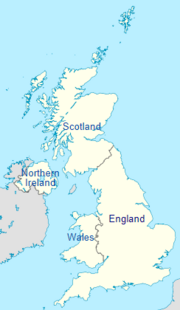
Beginning in 1998, a process of devolution has transferred legislative and executive powers previously held by United Kingdom institutions to Scotland, Wales and Northern Ireland.[202] As a result, a Scottish Government and Parliament, Welsh Government and Senedd (Parliament) and Northern Ireland Executive and Assembly have been created.[203] A similar process has not taken place for England.[202]
The UK does not have a codified constitution and constitutional matters are not among the powers that have been devolved. Under the doctrine of parliamentary sovereignty, the UK Parliament could, in theory, therefore, abolish the Scottish Parliament, Senedd or Northern Ireland Assembly.[204] In practice, it would be politically difficult for the UK Parliament to abolish devolution to the Scottish Parliament and the Senedd, because these institutions were created by referendum decisions.[205] The political constraints placed upon the UK Parliament's power to interfere with devolution in Northern Ireland are greater still, because devolution in Northern Ireland rests upon an international agreement with the Government of Ireland.[206] The UK Parliament restricts the three devolved parliaments' legislative powers in economic policy matters through an act passed in 2020.[207]
Scotland
Since 1999, Scotland has had a devolved national government and parliament with wide-ranging powers over any matter that has not been specifically reserved to the UK Parliament.[208][209] Their power over economic issues is significantly constrained by an act of the UK parliament passed in 2020.[207]
The current Scottish Government is a Scottish National Party minority government,[217] led by First Minister John Swinney, leader of the Scottish National Party. In 2014, the Scottish independence referendum was held, with 55.3% voting against independence from the United Kingdom and 44.7% voting in favour, resulting in Scotland staying within the United Kingdom. Local government in Scotland is divided into 32 council areas with a wide variation in size and population. Local councils are made up of elected councillors, of whom there are 1,223.[198]
The Scottish Parliament is separate from the Scottish Government, and is made up of 129 elected Members of the Scottish Parliament (MSPs) and is the law making body of Scotland. It does, however, scrutinise the work of the incumbent Scottish Government and considers any piece of proposed legislation through parliamentary debates, committees and parliamentary questions.[218]
Wales
Since 1999, Wales has a devolved national government and legislature, known as the Senedd. Elections to the Senedd use the additional member system. They have more limited powers than those devolved to Scotland.[219] The Senedd is able to legislate on any matter not specifically reserved to the UK Parliament through Acts of Senedd Cymru. The current Welsh Government is Labour, led by First Minister Vaughan Gething, who has been the First Minister since 2024. Local government in Wales consists of 22 unitary authorities, each led by a leader and cabinet elected by the council itself.
Northern Ireland
The devolved form of government in Northern Ireland is based on the 1998 Good Friday Agreement, which brought to an end a 30-year period of unionist-nationalist communal conflict known as The Troubles. The Agreement was confirmed by referendum and implemented later that year. It established power sharing arrangements for a devolved government and legislature, referred to as the Executive and Assembly respectively.[220] Elections to the Assembly use the single transferable vote system. The Executive and Assembly have powers similar to those devolved to Scotland.[221] The Executive is led by a diarchy representing unionist and nationalist members of the Assembly.[222] The First Minister and deputy First Minister of Northern Ireland are the joint heads of government of Northern Ireland.[223][224] Local government in Northern Ireland since 2015 has been divided between 11 councils with limited responsibilities.[200]
Foreign relations

The UK is a permanent member of the United Nations Security Council, a member of NATO, AUKUS, the Commonwealth of Nations, the G7 finance ministers, the G7 forum, the G20, the OECD, the WTO, the Council of Europe and the OSCE.[225] The UK has the British Council which is a British organisation based in over 100 countries specialising in international cultural and educational opportunities. The UK is said to have a "Special Relationship" with the United States and a close partnership with France – the "Entente cordiale" – and shares nuclear weapons technology with both countries;[226][227] the Anglo-Portuguese Alliance is considered to be the oldest binding military alliance in the world. The UK is also closely linked with the Republic of Ireland; the two countries share a Common Travel Area and co-operate through the British-Irish Intergovernmental Conference and the British-Irish Council. Britain's global presence and influence is further amplified through its trading relations, foreign investments, official development assistance and military engagements.[228] Canada, Australia and New Zealand, all of which are former colonies of the British Empire which share King Charles as their head of state, are the most favourably viewed countries in the world by British people.[229]
Law and criminal justice

The United Kingdom does not have a single legal system as Article 19 of the 1706 Treaty of Union provided for the continuation of Scotland's separate legal system.[230] Today the UK has three distinct systems of law: English law, Northern Ireland law and Scots law. A new Supreme Court of the United Kingdom came into being in October 2009 to replace the Appellate Committee of the House of Lords.[231] The Judicial Committee of the Privy Council, including the same members as the Supreme Court, is the highest court of appeal for several independent Commonwealth countries, the British Overseas Territories and the Crown Dependencies.[232]
Both English law, which applies in England and Wales, and Northern Ireland law are based on common law (or case law) principles.[233] It originated in England in the Middle Ages and is the basis for many legal systems around the world.[234] The courts of England and Wales are headed by the Senior Courts of England and Wales, consisting of the Court of Appeal, the High Court of Justice (for civil cases) and the Crown Court (for criminal cases).[235] Scots law is a hybrid system based on common-law and civil-law principles. The chief courts are the Court of Session, for civil cases,[236] and the High Court of Justiciary, for criminal cases.[237] The Supreme Court of the United Kingdom serves as the highest court of appeal for civil cases under Scots law.[238]
Crime in England and Wales increased in the period between 1981 and 1995, though since that peak there has been an overall fall of 66 per cent in recorded crime from 1995 to 2015,[239] according to crime statistics. As of June 2023, the United Kingdom has the highest per-capita incarceration rate in Western Europe.[240][241][242]
UK labour laws entitle staff to have a minimum set of employment rights including a minimum wage, a minimum of 28 days annual holiday, statutory sick pay and a pension. Same-sex marriage has been legal in England, Scotland, and Wales since 2014, and in Northern Ireland since 2020.[243] LGBT equality in the United Kingdom is considered advanced by modern standards.[244][245]
Military
His Majesty's Armed Forces consist of three professional service branches: the Royal Navy and Royal Marines (forming the Naval Service), the British Army and the Royal Air Force.[246] The armed forces of the United Kingdom are managed by the Ministry of Defence and controlled by the Defence Council, chaired by the Secretary of State for Defence. The Commander-in-Chief is the British monarch, to whom members of the forces swear an oath of allegiance.[247] The Armed Forces are charged with protecting the UK and its overseas territories, promoting the UK's global security interests and supporting international peacekeeping efforts. They are active and regular participants in NATO, including the Allied Rapid Reaction Corps, the Five Power Defence Arrangements, RIMPAC and other worldwide coalition operations. Overseas garrisons and facilities are maintained in Ascension Island, Bahrain, Belize, Brunei, Canada, Cyprus, Diego Garcia, the Falkland Islands, Germany, Gibraltar, Kenya, Oman, Qatar and Singapore.[248]
According to sources which include the Stockholm International Peace Research Institute and the International Institute for Strategic Studies, the UK has either the fourth- or the fifth-highest military expenditure. Total defence spending in 2024 is estimated at 2.3% of GDP.[249] Following the end of the Cold War, defence policy has a stated assumption that "the most demanding operations" will be undertaken as part of a coalition.[250]
Economy

The UK has a regulated social market economy.[253][254][255] Based on market exchange rates, the UK is the sixth-largest economy in the world and the second-largest in Europe by nominal GDP. Its currency, the pound sterling, is the fourth most-traded currency in the foreign exchange market and the world's fourth-largest reserve currency (after the United States dollar, euro, and yen).[256] Sterling was the 2nd best-performing G10 currency against the dollar in 2023 with a gain of about 5%, with only the Swiss franc performing better.[257][258] London is the world capital for foreign exchange trading, with a global market share of 38.1% in 2022[259] of the daily $7.5 trillion global turnover.[260]
HM Treasury, led by the Chancellor of the Exchequer, is responsible for developing and executing the government's public finance policy and economic policy. The Bank of England is the UK's central bank and is responsible for issuing notes and coins in the pound sterling. Banks in Scotland and Northern Ireland retain the right to issue their own notes, subject to retaining enough Bank of England notes in reserve to cover their issue. In 2022, the UK became the world's fourth-largest exporter behind only China, the US, and Germany.[261] The estimated nominal GDP of the UK for 2024 is £2.765 trillion.[262] This value is 23% higher than the 2019 figure of £2.255 trillion[263] before leaving the EU (at similar US and EU exchange rates to 2019).[264][s]

The service sector made up around 80% of the UK's GVA in 2021.[266] As of 2022, the UK is the world's second-largest exporter of services.[267] London is one of the world's largest financial centres, ranking second in the world in the Global Financial Centres Index in 2022. London also has the largest city GDP in Europe.[268] Edinburgh ranks 17th in the world, and sixth in Western Europe in the Global Financial Centres Index in 2020.[269]
The UK technology sector is valued at US$1 trillion, third behind the United States and China.[270] London has been named as the technology capital of Europe.[271] Tourism is very important to the British economy; London was named as Europe's most popular destination for 2022.[272][273] The creative industries accounted for 5.9% of the UK's GVA in 2019, having grown by 43.6% in real terms from 2010.[274] Creative industries contributed more than £111bn to the UK economy in 2018, growth in the sector is more than five times larger than growth across the UK economy as a whole as reported in 2018.[275] Lloyd's of London is the world's largest insurance and reinsurance market and is located in London.[276] WPP plc, the world's biggest advertising company, is also based in the UK. The UK is one of the leading retail markets in Europe and is home to Europe's largest e-commerce market.[277] John Lewis is the UK's largest employee owned business.[278]

The automotive industry employs around 800,000 people, with a turnover in 2022 of £67 billion, generating £27 billion of exports (10% of the UK's total export of goods).[279] In 2023, the UK produced around 905,100 passenger vehicles and 120,400 commercial vehicles, output was up 17.0% on the previous year.[280] Britain is known for iconic cars such as Mini and Jaguar,[281] also other luxury cars such as Rolls-Royce, Bentley and Range Rover. The UK is a major centre for engine manufacturing: in 2022 around 1.5 million engines were produced.[279] It is also the world's fourth-largest exporter of engines, as of 2021.[282] The UK motorsport industry employs more than 40,000 people, comprises around 4,300 companies and has an annual turnover of around £10 billion.[283] 7 of the 10 Formula One teams are based in the UK, with their technology being used in supercars and hypercars from McLaren, Aston Martin and Lotus.[t]
The aerospace industry of the UK is the second-largest national aerospace industry in the world depending upon the method of measurement and has an annual turnover of around £30 billion.[284] The UK space industry was worth £17.5bn in 2020/21 and employed 48,800 people. Since 2012, the number of space organisations has grown on average nearly 21% per year, with 1,293 organisations reported in 2021.[285][286] The UK Space Agency has stated in 2023 that it is investing £1.6 billion in space related projects.[287]
The agriculture industry is intensive, highly mechanised and efficient by European standards, producing approximately 60% of the country's overall food requirements and 73% of its indigenous food needs, utilising around 0.9 per cent of the labour force (292,000 workers).[288] Around two-thirds of production is devoted to livestock, one-third to arable crops. The UK retains a significant, though much reduced fishing industry. It is also rich in a variety of natural resources including coal, petroleum, natural gas, tin, limestone, iron ore, salt, clay, chalk, gypsum, lead, silica and an abundance of arable land.[289] The UK has among the highest levels of income inequality in the OECD, but has a very high HDI ranking.[290][291]
Science and technology

England and Scotland were leading centres of the Scientific Revolution from the 17th century.[293] The United Kingdom led the Industrial Revolution from the 18th century, and has continued to produce scientists and engineers credited with important advances.[294] Major theorists from the 17th and 18th centuries include Isaac Newton, whose laws of motion and illumination of gravity have been seen as a keystone of modern science;[295] from the 19th century Charles Darwin, whose theory of evolution by natural selection was fundamental to the development of modern biology, and James Clerk Maxwell, who formulated classical electromagnetic theory; and more recently Stephen Hawking, who advanced major theories in the fields of cosmology, quantum gravity and the investigation of black holes.[296]
The Department for Science, Innovation and Technology (DSIT) is responsible for helping to encourage, develop and manage the UK's scientific, research, and technological outputs. Scientific research and development remains important in British universities, with many establishing science parks to facilitate production and co-operation with industry.[297] In 2022 the UK retained its number one spot for technology in Europe reaching a combined market value of $1 trillion. Cambridge was named the number one university in the world for producing successful technology founders.[298]
For four consecutive years, from 2020 to 2023, the UK maintained its fourth-place ranking in the Global Innovation Index, a position determined by approximately 80 indicators encompassing the political environment, education, infrastructure, and knowledge creation, among others.[299][292] During 2022, the UK produced 6.3 per cent of the world's scientific research papers and had a 10.5 per cent share of scientific citations, the third highest in the world (for both). The UK ranked 1st in the world for Field-Weighted Citation Impact.[300] Scientific journals produced in the UK include publications by the Royal Society, Nature, the British Medical Journal and The Lancet.[301]
Transport


A radial road network totals 29,145 miles (46,904 km) of main roads, 2,173 miles (3,497 km) of motorways and 213,750 miles (344,000 km) of paved roads.[144] The M25, encircling London, is the largest and busiest bypass in the world.[302] In 2022, there were a total of 40.8 million licensed vehicles in Great Britain.[303]
The UK has an extensive railway network of 10,072 miles (16,209 km). In Great Britain, the British Rail network was privatised between 1994 and 1997, followed by a rapid rise in passenger numbers. Great British Railways is a planned state-owned public body that will oversee rail transport in Great Britain. The UK was ranked eighth among national European rail systems in the 2017 European Railway Performance Index assessing intensity of use, quality of service and safety.[304]
The UK has a direct train between London and Paris which takes 2hrs 16mins[305] called the Eurostar, it travels through the Channel Tunnel under the English Channel, at 23.5 miles long it is the world's longest undersea tunnel.[306] There is also a car service through the tunnel to France called LeShuttle. The Elizabeth line, a rail link running between East and West London, was named in honour of Queen Elizabeth II in 2016 and opened in 2022. It was Europe's largest construction project at the time and is estimated to bring in £42 billion to the UK economy.[307][308] Another major infrastructure project is High Speed 2 (HS2), it is a new high speed railway currently under construction. It will link London with Birmingham, with the potential to extend further north and capable of speeds of up to 225 mph.[309][310]
In 2014, there were 5.2 billion bus journeys in the UK, 2.4 billion of which were in London.[311] The red double-decker bus has entered popular culture as an internationally recognised icon of England.[312] The London bus network is extensive, with over 6,800 scheduled services every weekday carrying about six million passengers on over 700 different routes making it one of the most extensive bus systems in the world and the largest in Europe.[313]
During 2023, UK airports handled a total of 272.8 million passengers.[314] In that period the three largest airports were London Heathrow Airport (79.1 million passengers), Gatwick Airport (40.9 million passengers) and Manchester Airport (28.1 million passengers).[314] London Heathrow Airport, located 15 miles (24 km) west of the capital, is the world's second busiest airport by international passenger traffic and has the most international passenger traffic of any airport in the world;[315] it is the hub for the UK flag carrier British Airways, as well as Virgin Atlantic.[316]
Energy
Zdroj:https://en.wikipedia.org?pojem=U.K.Text je dostupný za podmienok Creative Commons Attribution/Share-Alike License 3.0 Unported; prípadne za ďalších podmienok. Podrobnejšie informácie nájdete na stránke Podmienky použitia.
Antropológia
Aplikované vedy
Bibliometria
Dejiny vedy
Encyklopédie
Filozofia vedy
Forenzné vedy
Humanitné vedy
Knižničná veda
Kryogenika
Kryptológia
Kulturológia
Literárna veda
Medzidisciplinárne oblasti
Metódy kvantitatívnej analýzy
Metavedy
Metodika
Text je dostupný za podmienok Creative
Commons Attribution/Share-Alike License 3.0 Unported; prípadne za ďalších
podmienok.
Podrobnejšie informácie nájdete na stránke Podmienky
použitia.
www.astronomia.sk | www.biologia.sk | www.botanika.sk | www.dejiny.sk | www.economy.sk | www.elektrotechnika.sk | www.estetika.sk | www.farmakologia.sk | www.filozofia.sk | Fyzika | www.futurologia.sk | www.genetika.sk | www.chemia.sk | www.lingvistika.sk | www.politologia.sk | www.psychologia.sk | www.sexuologia.sk | www.sociologia.sk | www.veda.sk I www.zoologia.sk


